Starting in version 1903, Windows 10 reserves some disk space that allows the OS to used it for updates, apps, temporary files, and system caches even if your device is running low on the disk space on the system partition (C:).
In version 1903 and above, Microsoft has made a few changes to how Windows 10 manages disk space. Some disk space, identified as reserved storage, will be set aside to be used by updates, apps, temporary files, and system caches.
Windows 10 will reserve some disk space to ensure that critical OS functions always have access to disk space. If there’s no enough space on the system drive, Windows and application will become unreliable. Windows Update may fail to download new update packages.
Reserved storage solves this issue.
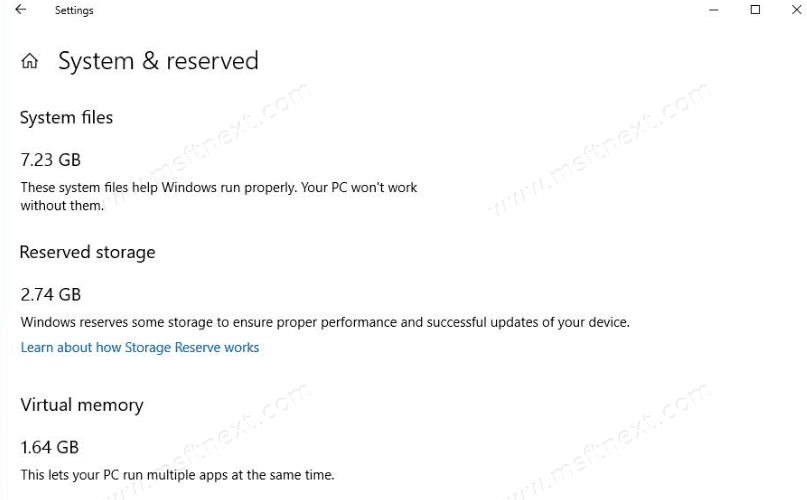
With reserved storage, all the updates, apps, temporary files, and caches are less likely to take away from valuable free space and should continue to operate as expected.
How much of storage is reserved
The reserved storage size will start at about 7GB, however the amount of reserved space will vary over time based on how you use your device. For example, temporary files that consume general free space today on your device may consume space from reserved storage in the future.
Microsoft may adjust the size of reserved storage in the future based on diagnostic data or feedback. Also, the following two factors influence how reserved storage changes size on your device:
-
Optional features. Many optional features are available for Windows. These may be pre-installed, acquired on demand by the system, or installed manually by you. When an optional feature is installed, Windows will increase the amount of reserved storage to ensure there is space to maintain this feature on your device when updates are installed. You can see which features are installed on your device by going to Settings > Apps > Apps & features > Manage optional features. You can reduce the amount of space required for reserved storage on your device by uninstalling optional features you are not using.
-
Installed Languages. Windows is localized into many languages. Although most of our customers only use one language at a time, some customers switch between two or more languages. When additional languages are installed, Windows will increase the amount of reserved storage to ensure there is space to maintain these languages when updates are installed. You can see which languages are installed on your device by going to Settings > Time & Language > Language. You can reduce the amount of space required for reserved storage on your device by uninstalling languages you aren’t using.
Tip: Find Reserved Storage Size in Windows 10
Here’s how you can enable or disable Reserved Storage in Windows 10.
To Enable or Disable Reserved Storage with PowerShell in Windows 10,
- Open PowerShell as Administrator.
- Type
Get-WindowsReservedStorageStateto see if the Reserved Space feature is enabled or disabled.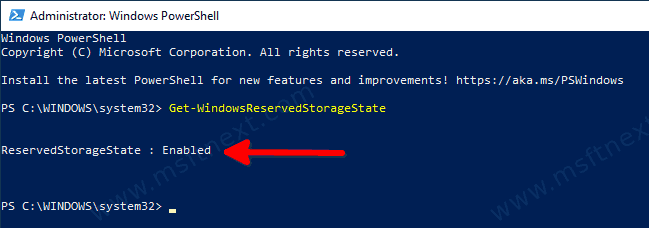
- Execute the following command to enable Reserved Storage:
Set-WindowsReservedStorageState -State Enabled. - Run the following command to disable Reserved Storage:
Set-WindowsReservedStorageState -State Disabled.
You are done. The change will be applied instantly, no restart required.
Note: If Windows 10 is performing a servicing operation, e.g. it is installing an update, you won’t be able to enable or disable the Reserved Storage feature. The operation will fail. You should try to execute the appropriate command later. You will see the following message:

Enable or Disable Reserved Storage in Windows 10 with Dism
- Open a command prompt as Administrator.
- Type
DISM.exe /Online /Get-ReservedStorageStateto see if the Reserved Space feature is enabled or disabled.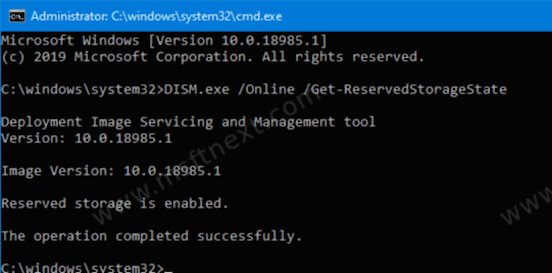
- Execute the following command to enable Reserved Storage:
DISM.exe /Online /Set-ReservedStorageState /State:Enabled.
- Run the following command to disable Reserved Storage:
DISM.exe /Online /Set-ReservedStorageState /State:Disabled.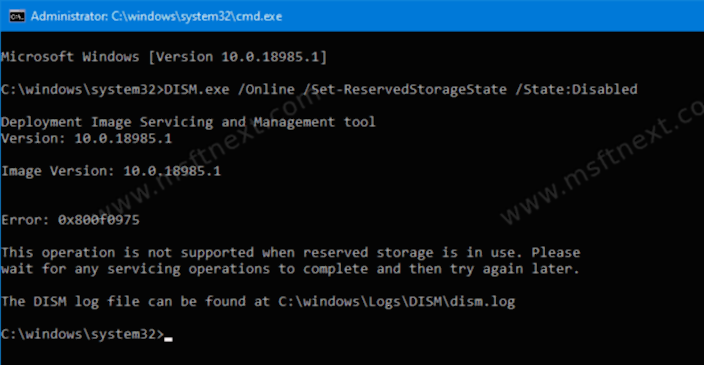
Enable Reserved Storage in Registry Editor
- Run
regedit.exefrom the ‘Run’ dialog (press Win + R). - Go to the following Registry key:
HKEY_LOCAL_MACHINE\SOFTWARE\Microsoft\Windows\CurrentVersion\ReserveManager. See how to directly open a Registry key with one click. - On the right, modify or create a new 32-Bit DWORD value ShippedWithReserves. Even if you are running 64-bit Windows , it is still required to create a 32-bit DWORD value.
- Set the above value to 1 to enable Reserved Storage. A value data of 0 will disable it.
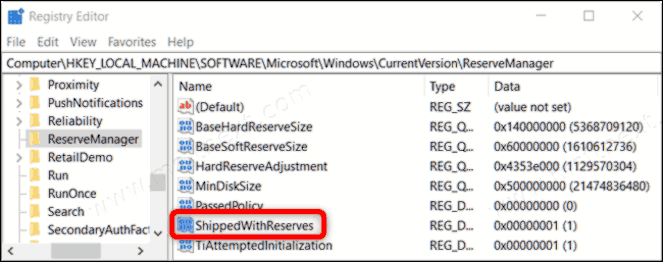
- Restart Windows 10.
More details on how Reserved Storage works
The amount of reserved space will vary over time based on your device is being used. E.g. temporary files that are now located in general free space today on your device may be relocated to the reserved storage in the future. Also, over the last several releases Microsoft reduced the size of Windows for most customers.
When Reserved Storage is enabled, it will instantly reserve its full allotment of disk space. However, on devices with small storage drives, enabling reserved storage will leave the user space and will only take the minimum—which is 2% of system volume capacity or 3GB of disk space, whichever is lower—to ensure that the device is functional and accessible to the user for further operations. Reserved storage will grow back to its original allocated size as space becomes available, such as when old Windows installations are removed or then Storage Sense cleanup tasks are conducted.
